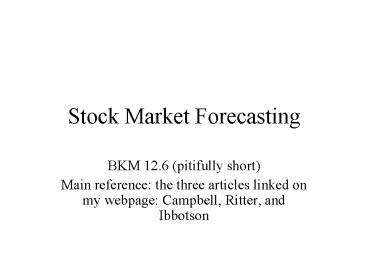Stock Market Forecasting
1 / 12
Title: Stock Market Forecasting
1
Stock Market Forecasting
- BKM 12.6 (pitifully short)
- Main reference the three articles linked on my
webpage Campbell, Ritter, and Ibbotson
2
Two Benchmarks
- you ought to know.
- The Fed Model says the market fairly priced when
the earnings yield (E1/P0) is equal to 10-year
treasury yields. - Lynchs model says that a security is fairly
priced if its PEG ratio (P/E divided by 5-year
year growth forecast) is less than one. - These models are ad-hoc (i.e. not motivated by
fundamental economics). They are theoretically
wrong in that they compare real and nominal
rates, do not control for risk, etc.) - But they still may be useful
3
- Most common approach for individual securities
- Cannot work for forecasting the market itself
(circular argument!). Instead use
Expected Premium on the Market
Current risk-free rate
4
Equity Premium Puzzle
- The historical data from 1926-present of the
SP500 has a very high arithmetic rate of return. - Though risk is higher than with bonds, there are
very few long-run periods over which bonds win. - Why would any long-term investor buy bonds?
- Possible Answer 1 Past returns were, in part, a
surprise to investors. Future returns will not
replicate past returns.
5
An Economic Argument
- Possible Answer 2 Historical risk premium should
be higher than future risk premium - Good old days had
- Larger transaction costs for entering the market
fewer investors bearing the same amount of risk - Less diversified basket of publicly traded
securities - Less available information (greater adverse
selection problem?) - (Usually) higher capital gains taxes
6
Future Risk Premium
- If some combination of Reason 1 and Reason 2 are
valid, future risk premium should be less than
historical risk premium of 7. - Ibbotson forecast 10 in the 70s and he was
right. Hes still forecasting 9 nominal, or
about 7 real. - So is the Social Security Advisory Board.
- Many others are shaving 3 off of this number.
7
John Campbells Calculation
- 1871-1997
- Div yield 5.4
- Geometric Stock Price Growth 1.6 (real)
- gt 7.0 real
- 1802-1997
- Div yield 4.9
- Geometric Stock Price Growth 2.1
- gt 7.0 real.
8
John Campells Calculation
- New Div Yield 1.4 (!!!)
- Dollars going to repurchases correspond to
somewhat higher g than historical number (approx
2) - New real RETURN should be in the neighborhood of
3.7 to 4.7. - Since TIPS were yielding 3.5, equity premium is
probably less than 1!
at the time Campbell was writing
9
Why is current D/P so low?
- Guess 1 Prices now are simply too high.
- D/P will correct over time as market returns are
disappointing. - Guess 2 Dividends now are temporarily low.
- High prices mean that the market forecasts high
growth in earnings. Once this growth is
realized, the ratio will return to normal. - Ibbotson favors this explanation, and uses
historical D/P in his 9 forever calculation. - Guess 3 Structural Decline in Equity Premium
- You might argue that 1 actually makes sense from
an economic perspective. - (See again Possible Answer 2)
10
Campbells Middle-of-the-Road Position
- Campbell retreats from his back-of-envelope
calculation that equity premium lt 1. - Maybe all three explanations have some merit.
- Forecasts real geometric return of 5 to 5.5.
- Given TIPs return, this is a 1.5 to 2.0 equity
premium.
11
Ritters Analysis
- Similar analysis as Campbell, but emphasizes
interpreting g as growth rate in dividends rather
than share prices. - Argues that if dividends grow at a reasonable
rate per capita, they will not eventually
overwhelm labor income. - Suggests g2.5
- D/P 1.5.
- gt Real return 4.0.
- Given TIPs return of 3.3, this is an equity
premium of .7.
12
Who is Right?
Guess 2 D/P is temporarily low
Guess 1 Prices are too high
The Market Knows What its Doing
The Market Doesnt Know What its Doing































